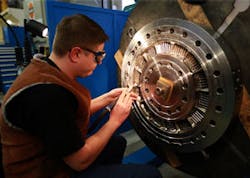Casket manufacturers can’t rely on one of life’s unquestionable certainties for steady demand anymore. With cremation rising in popularity, the industry is seeking new sources of revenue. In 2010, Hillenbrand Inc., owner of the Batesville Casket Co., began diversifying its business beyond the funeral products industry through acquisitions.
The company’s latest acquisition was its purchase of German extrusion and bulk-material handling equipment manufacturer, Coperion Capital, for 419 million euros, or approximately $545 million. “One area where we have been focusing is manufacturers of process equipment, and the Coperion acquisition fits right into that strategy,” says Diane Bohman, integration leader and senior vice president of corporate strategy at Hillenbrand.
See Also: Lean Manufacturing Leadership Best Practices
Diversification through acquisitions is a strategy many manufacturers have adopted recently to transition away from both volatile and flat markets. Industrial merger and acquisition activity rose 26% in third-quarter 2012 compared with the same three-month period in 2011, PricewaterhouseCoopers reported in its quarterly M&A study. Deal value in the same period increased substantially, up 150%, driven by an increase in “mega deals” valued at $1 billion or more. PwC expects the increase in M&A activity to continue in 2013 as U.S. manufacturers spend large cash reserves built through restructuring activities over the past several quarters.
While the increase in deals means more potential growth opportunities for manufacturers, it also poses many risks. Integration challenges, including cultural disparities, can offset expected synergies from a merger. M&A professionals responding to a survey released in January by tax and advisory firm KPMG cited cultural, human-capital and operational and rationalization issues as their top integration concerns in 2013.
Mergers and acquisitions are always a gamble, but manufacturers can mitigate some of the inherent risks through due diligence and an integration plan that takes effect early in the process—sometimes before the deal is even complete.
Culture Assessments
If anyone knows the importance planning plays in the acquisition process, it’s Alexander “Sandy” Cutler, president and CEO of diversified manufacturer Eaton (IW 500/72). Eaton’s roots are in auto components manufacturing, but the company has steadily been transitioning into other industries. Since 2000, the Cleveland-based company has acquired about 65 companies, primarily in the electrical, hydraulics and aerospace industries. The $13 billion purchase of electrical equipment supplier Cooper Industries in May 2012 was the company’s largest-ever acquisition.
The cultural-integration process actually begins before completing the transaction, Cutler tells INDUSTRYWEEK. Eaton’s assessment of an acquisition prospect includes careful examination of the target company’s ethical standards and leadership style before finalizing a deal. While Eaton has completed many transactions in recent years, the company has also walked away from several proposed deals because of a cultural mismatch, Cutler says.
“Our rule has always been that no acquisition is better than a bad acquisition, and a bad acquisition can come because you pay too much or because the leadership style and employee culture is so abruptly different than yours that it’s going to take you a very long time to replace it with your own,” Cutler says. Many of Eaton’s acquisitions have been long-time suppliers or customers, which provided Eaton with additional insight into how the firm conducts business, Cutler adds.
When Hillenbrand is looking to acquire a company, it assesses whether the acquisition prospect is “lean ready,” Bohman says. Hillenbrand, based in Batesville, Ind., has a well-established lean program in place that has gained national recognition, including several IW Best Plants awards for its Batesville Casket plants.
Hillenbrand checks whether a company is already involved in lean activities, and if so, how advanced the company is in lean manufacturing. If the company isn’t practicing lean, it analyzes how much instruction would be required to bring it up to speed with Hillenbrand’s program. The assessment process includes a visit to the company’s manufacturing sites and other key areas of activity, including logistics and back-office functions, Bohman says.
“We take a look at how they operate,” Bohman explains. “We talk to the management teams to understand how they think, how they approach their operations, how they measure their activity and results. We also talk to the senior management team to understand their understanding of lean—if they have a different approach that they use. So a lot of it is observation and questions.”
Companies that struggle with mergers often do so because they’ve waited until after the transaction is complete to begin integrating corporate cultures, says Matt Jamison, managing director of investment bank P&M Corporate Finance.
“Too many companies are focused on financial diligence of the transaction and aren’t focused enough on culture and customer retention,” says Jamison, whose firm provides M&A advisory services and worked with Hillenbrand.
After the Deal Closes
After Hillenbrand completes a buyout, the company introduces its newly acquired firm to the Hillenbrand version of lean through a “lean boot camp,” Bohman says. The lean boot camp is an intense training program that takes place over several days for the top management people who are joining the Hillenbrand team. Hillenbrand then works with the new organization to identify continuous-improvement projects that could benefit the entire company.
Communication is critical during this initial integration period, say experienced M&A professionals. The first day after Eaton completed the Cooper transaction, Eaton representatives visited nearly all of Cooper’s 100-plus sites, Cutler says. “Those were open communications meetings to help them understand our values and how we do business,” he recalls. “It’s a two-way communication so employees can ask their questions. That’s about establishing a culture of openness and transparency.”
Eaton follows that with training the new employees on the company’s ethical values. The company then focuses on leadership integration, which involves the leaders of Eaton and the new organization joining together to discuss business processes. “It is very much an immersion process where we try to get the companies to come together sooner rather than later,” Cutler says. “And it’s not a situation where the Eaton idea wins. We want to understand the best way to do things.”
Aligning the leadership teams on the company’s core objectives should take place as the companies announce their intent to merge, which typically takes place months before the deal closes, says Tracy Benson, CEO of On the Same Page LLC, an M&A consultancy firm based in Katonah, N.Y. “Some of this will not be known until the process unfolds; however, the leadership and integration teams need to be thinking about these issues well ahead of time,” Benson says. “This allows the team to set direction and allocate resources with communication that is clear, in line with what will be taking place and consistent.”
Preparing the sales organization is another immediate step manufacturing leaders should take after the close date, says Mary Cianni, global leader, M&A services, Towers Watson. For instance, if sales representatives from both organizations have overlapping clients, the company needs to coordinate who will handle that particular client to avoid confusion, Cianni says. The company may also want to consider establishing prepared talking points for the sales staff, such as frequently-asked questions, to address customer questions, she says. More importantly, says Cianni, companies need to quickly make any planned changes to the sales staff so the organization doesn’t lose top-performing sales people who flee because of the uncertainty.
One of Eaton’s top priorities after an acquisition is completing the integration process within a two- to three-year timeframe, Cutler says. “We believe when these integrations go on four or five or six years, it’s akin to rolling thunder in that no one knows what the final state will be,” he says. “While I think sometimes people think a slow integration will be much better, I think most people would prefer to get on with the work and get it behind them versus not knowing how many more changes are coming sometime in the near future.”
3 Post-Merger Priorities
Bringing two organizations together can be a confusing, disorganized mess if companies don’t have a clear post-merger strategy in place, says Wayne Pinnell, managing director of Haskell & White LLP. Pinnell is a certified public accountant who has consulted with several midsize manufacturing firms during the merger process. Here, Pinnell outlines three steps manufacturers should take immediately following a merger:
- Communication with employees, suppliers and customers is of high importance after a merger. Both companies need to discuss the “why” and “what it means” for each group. Employee issues may include discussions of headcount realignment, growth opportunities and new or improved benefits. Manufacturers may need to speak with suppliers about their increased needs, volume discounts, lead times or just-in-time considerations. Customers will want to know what the merger means in terms of product and service offerings and any changes they should expect in the relationship.
- The new entity must evaluate redundancies in personnel, systems, facilities and equipment. There is usually a planned “efficiency factor” for such mergers, and there should be a plan to integrate and eliminate redundancies to help achieve the efficiency goals.
- The new entity must conduct an overall contract review, negotiation and revision for banking, suppliers, sales commitments, benefit packages, etc.






